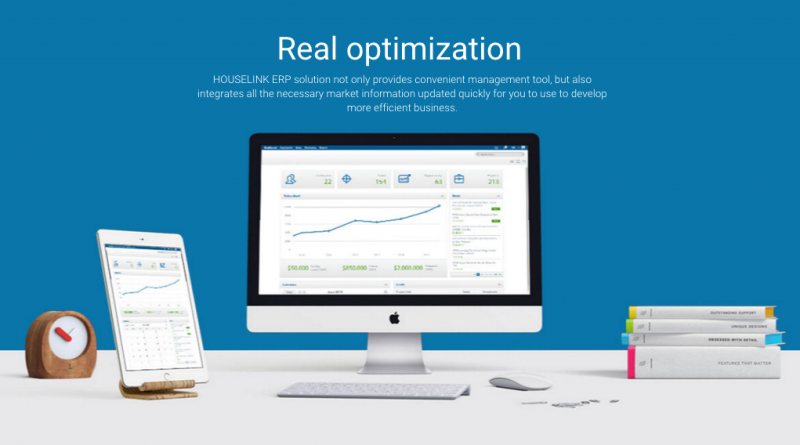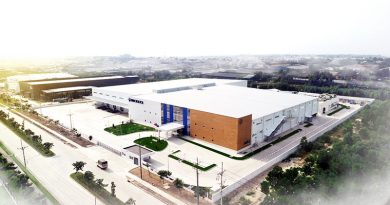Sustainable Business Process Management (SBPM) for Construction Businesses
Young Woong, Song1 and Yoon Ki, Choi2*
1 MEST-NRF Research Professor, Ph.D., Research Institute of Frontier Technology, Soong sil University, Seoul, Korea
2 Associate Professor, Ph.D., Dept of Architectural Engineering, Soong sil University, Seoul, Korea
* Corresponding author (ykchoi@ssu.ac.kr)
ABSTRACT: Construction companies require a management system to increase efficiency and profit due to the competitive and globalized business environment. Changing business environment also requires prompt and flexible responses such as establishing management strategies, increasing value of intangible assets, and measuring and collecting real-time data. Specific approaches are also called for to achieve realistic, organized and rational management amid constant and accelerating changes in the business environment of construction industry. Since the 1990s, construction companies have made various attempts to innovate their business structure both internally and externally by means of BPR, Six Sigma, PI and Workflow. Some improvements were made, but most of them were temporary and insufficient in providing the much-needed promptness for businesses to respond to the changes. In addition, various information technologies including ERP, MIS and PMIS to support the business process have been utilized, but they were estranged from the business process management and failed to meet the strategic goals of the companies as the technologies were function-oriented and focused on input/output processes and data flow. In the construction industry, only a handful of companies considered adoption of BPM and carried out basic theory-oriented researches. Accordingly, this research suggests a Sustainable Business Process Management (SBPM) model that improves and visualizes the process, executes and controls the systems and participants, and monitors and sustains business process improvement of the construction companies.
Keywords: BPM (Business Process Management), IT (Information Technology), PI (Process Innovation)
1. INTRODUCTION
Since the 1990s, construction companies have made various attempts to innovate their business structure both internally and externally by means of BPR, Six Sigma, PI and Workflow. Some improvements were made, but most of them were temporary and insufficient in providing the much-needed promptness for businesses to respond to the changes. In addition, various information technologies including ERP, MIS and PMIS to support the business process have been utilized, but they were estranged from the business process management and failed to meet the strategic goals of the companies as the technologies were function-oriented and focused on input/output processes and data flow. In the construction industry, only a handful of companies considered adoption of BPM and carried out basic theory-oriented researches.
Elzinga (1995) emphasizes that BPM is a structural and analytical method for managing the complexity of variable business processes. Smith and Finga (2002) describe managing business processes and resolving the problem of the separation of business and IT. After this, the advent of the BPM from a technological viewpoint develops from workflow and EAI. Smith. H (2003) suggests a scenario of BPM applications centered on control function. Verner (2004) submits the advantage of process monitoring which economizes on cost, time and wages. These researches on BPM were conducted by other industries; construction- oriented research on the subject of BPM application is hard to find and only a few companies are considering the new system. Further researches on BPM for construction companies are in great need as companies lack systematic guidelines and methods to adopt BPM. This research is distinguished from the existing ones in that it focuses on aspects of implementing and controlling work-related personnel and systems in a consistent manner within the business process, improving and visualizing both internal and external business processes, and carrying out a constant effort to monitor and improve business processes to adopt a business process management that can cater to management strategies of construction companies. Table 1 illustrates the result of a comparative analysis of the fields supported by SBPM for both previous studies and this research.
Table 1. Fields supported by SBPM
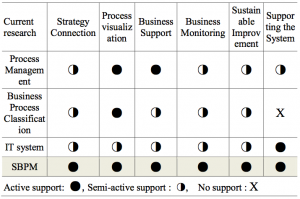
This research suggests a Sustainable Business Process
Management (SBPM) model that improves and visualizes the process, executes and controls the systems and participants, and monitors and sustains business process improvement of the construction companies.
Table 2. Research Scope
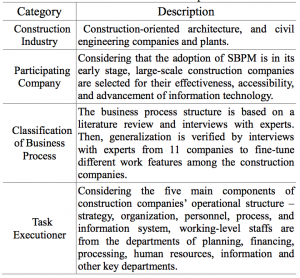
2. Current Status of Business Process Management (BPM) in the Construction Industry
“B” Construction Company introduced Business Process Reengineering (BPR) in 1990 to improve corporate culture according to the company’s ‘management philosophy’ and ‘long-term management strategy’ and to enhance business efficiency along with heightened competition in both domestic and foreign markets. To improve the work structure, 8 out of 19 major work processes were selected for BPR. Meanwhile, “H” Company implemented the first stage of PI in 2003; the company organized seven teams and identified nine tasks for innovation. Currently, the company is undergoing the second stage of PI and has plans to establish a BPM system based on the achievements of PI. “G” Company strives to improve its construction management and customer value through Six Sigma practice, and is also considering the adoption of BPM. Table 3 shows the current status of process management implementation by major construction companies according to the implemented methods.
Table 3. current status of business process management
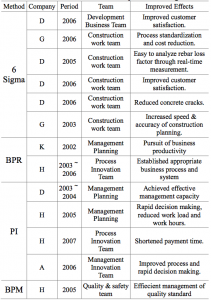
Various process management models have been applied according to the changing demands and business environments. Under the rapidly changing circumstances, existing process management models need to advance and reflect new environments in the construction industry, emerging needs for business process management and particular demands from IT. Along with the advancement, construction companies need to adopt BPM for the following reasons.
Table 4. Rise of BPM Model for Process Management
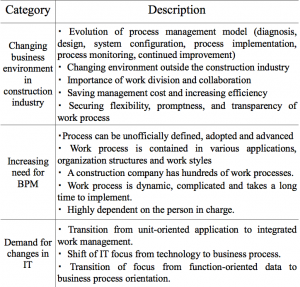
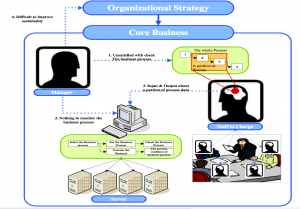
Fig. 1 Illustrates the aforementioned points
Currently, BPM models adopted by the construction companies for performance improvement turned out to be largely unrecognizable since they are contained in individual knowledge, work styles and applications. Also, the existing models are heavily dependant on people and organizational structure, and efforts to continuously improve business process are inefficient. Figure 1 illustrates the aforementioned points.
3. Definition of SBPM
Smith (2003) defined BPM, the third wave, as a well- organized and designed activity that manages and improves business processes to raise productivity, and a methodology or a system that supports these activities. Weskw (2004) agreed that BPM is a methodology used to design, execute and control operating processes related to human, organization, application, document and other information sources, and it supports business processes to utilize a system. As mentioned above, definitions of BPM in the existing researches are as follows:
Table 5. Definitions of BPM
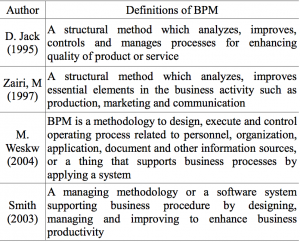
However, lack of selection and feedback on business processes in line with corporate core strategy, sequential application plans and sustainable management plans through BPM were pointed out as major problems. Consequently, this paper defines SBPM model application of the construction industry as follows:
A system to improve and visualize the business process with in and out of the company by applying the business process which is related to the strategy of the construction company; to execute and control human resources and systems (related to work performance) suitable to the business process; to continuously monitor and improve the business process.
The model is expected to realize business efficiency through business process improvement and to eliminate inefficient factors by maintaining the system. A conceptual diagram of the SBPM definition and the considerations are explained in Fig.2. Applying an SBPM model to business strategy of construction industry requires a sequential adoption. The reason for this is that feedbacks from trial and error can help reduce potential risks when it is applied to other tasks.
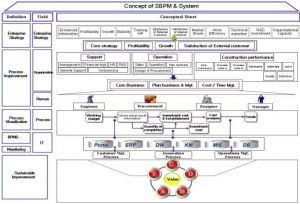
Fig.2 Definition of SBPM
4. Critical Factors to Successfully Adopt Sustainable Business Process Management (SBPM) Model
To apply an SBPM model, continuous business process improvement by eliminating unnecessary tasks and operation of information system that supports the business process are required. For sequential adoption of the SBPM model, key business strategies are needed to be established and priorities for applying SBPM to unit tasks in accordance with the key business strategies are needed to be identified. Then, the first-stage goal of improving the business process should be achieved in the order of: work analysis, analysis of relationship between work and application, problem identification and business process improvement. In order to achieve continued improvement of the business process with application of the SBPM model, work implementation, performance management and information management are required. Optimal work structure can be established by continuously extracting wasteful factors in the implementation process and improving them.
The SBPM model establishes an optimal business process environment by continuously identifying and eliminating valueless tasks in the stages of business process, work implementation, performance management, and information management. Figure 3 illustrates concept of the SBPM model that is based on key success factors with an effort to eliminate unnecessary factors in the business process and to improve unit tasks.
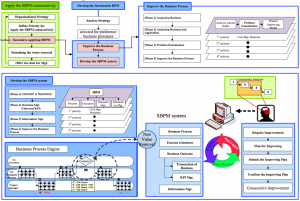
Fig.3 concept of the SBPM model
5. Architecture of the SBPM Model
Fig. 4 shows architecture of the SBPM model that primarily improves problems of unit business in construction firms and reflects the design principles of the model.
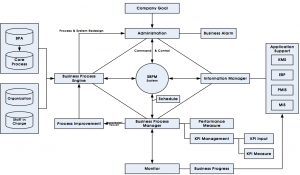
Fig. 4 Architecture of SBPM Model
The module of SBPM model is categorized into 7 large elements: ties with company strategy, manager, business process engine, information manager, business process manager, monitoring system and continuous improvement. The module of ties with company strategy is to reflect the core strategy of construction firms and to plan future strategies. The business process engine is a process management module that supports business processes and enables one to search the processes undertaken by an officer in charge in accordance with the code of business process structure, and it also allows one to process tasks based on the process as it is interlinked with the information manager module. The business process manager module is to measure results and manage KPI continuously, and it is also interlinked with the business monitoring module. The manager module is meant to continuously reflect improvements in relation with tasks, information support and business improvement, and to control business. This module has a role as an information provider for formulating future company strategy.
The SBPM model is focused on the process. The process is subdivided into levels of mega process, process chain, process and activity based on a value chain and linked to the data by the code of each process level. Each process is then delivered to each task operator based on job plan and its progress status is marked with start and completion date data.
The application already in use is processed in connection with the business process and an individual task list. Monitoring and performance management of each business is measured in connection with each process based on the KPI data.
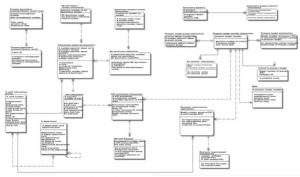
Fig. 5. ERD for adopting SBPM model
6. Business process monitoring
Business process monitoring is divided into two monitoring systems, one for task managers and one for task operators. The monitoring system for the task operator monitors the preceding operator, the follow-up operator and the status of an ongoing task. The monitoring system for the task manager provides integrated functions, such as monitoring processes across the enterprise and taking measures on processes that cause delays or problems. Task operators can check preceding status of their task process and follow-up operator of the task, and monitor the status and results of their own task. Moreover, current status of the processes such as completed, delayed, etc. are indicated on the visualized process and the operator can also check operating bodies of each task.
For senior managers, it provides integrated information of each process across the enterprise and status of the processes such as delayed, on-time, or finished early. The manager can check the processing status and operators of each task by clicking ‘Detailed Information’ icon. Fig. 6 shows this process.
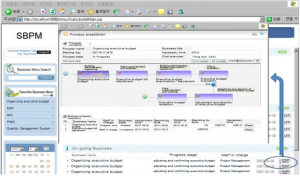
Fig. 6 Business process monitoring
7. Performance management of business process
KPI for continuous management of the SBPM model is managed from respective processes’ and organizations’ perspectives. Further, the KPI management shows performance status of the business process which construction companies can use as fundamental data for establishing future business strategy.
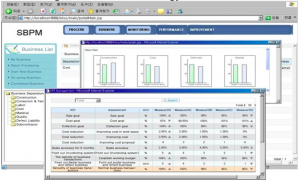
Fig. 7. Performance management of business process
The performance measurement of each process shows comprehensive performance of a process selected through Explorer and if you search for detailed information, it will show the performances in grades based on each KPI evaluation items and actual achievements on the goal. It also shows ups and downs of the current performance compared to the past performances. Fig. 7 shows this process.
8. Expected Outcomes of the SBPM Model
Interviews and surveys of working-level staffs were conducted to prove how the SBPM model application can actually redress the problems of business process management. To examine the expected outcome of the SBPM model, working-level staffs with experience of more than 10 years were selected from sample companies and briefed thoroughly on the SBPM model. Table 6 outlines the survey conducted to analyze the expected outcome of SBPM.
Table 6. Outlines of the survey for expected outcome
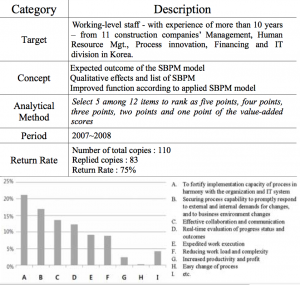
Fig.8 Expected Outcomes
The analysis of the effects of SBPM revealed that the most anticipated outcome (21%) is ‘to reinforce implementation capacity of a process in harmony with the organization and IT system’ as shown in Figure 6. This is followed by ‘securing process capability to promptly respond to internal and external demands for changes and business environment changes (16%)’, ‘effective collaboration and communication (15%)’, ‘real-time evaluation of progress status and outcomes (13%)’, ‘expedited work execution (12%)’, ‘reduced work load and complexity (9%)’, and ‘increased productivity and profit (8%).
9. Conclusion
This research examined the critical need to adopt BPM to cope with changing paradigms in the construction industry and reasons for unsuccessful process management and application of BPM for construction companies, related problems, limitations of previous researches, and provided an SBPM model that enables continuous improvement for construction businesses. The model visualizes the business process and establishes human resources and systems related to the tasks in a process-oriented manner. This enables elimination of wasteful factors in the process of implementing, controlling, monitoring and evaluating performance of business processes, and eventually builds an optimal business process environment.
In consideration of the continuous improvement, SBPM model is consisted of seven modules including linking company strategies, administrators, business process engine, information management, business process management, system monitoring and continued improvement, and it suggests system architecture.
By pursuing improvement of business processes and information strategies simultaneously, the model ensures efficiency and promptness of the business process, materializes a fundamental business process management system and enables continued improvement of the business.
Acknowledgement
This work was supported by the National Research Foundation of Korea Grant funded by the Korean Government(Ministry of Education, Science and Technology).[NRF-2010-359-D00027]
REFERENCES
[1] Deming, W.E. “Out of the Crisis analysis”, MIT, Center for Advenced Engineering Study, 1986.
[2] Hammer, “The Reengineering Revolution analysis”, Harper Collins, 1995.
[3] Howard Smith and Peter Fingar. “BPM, The Third Wave analysis”, Sigma Insight, 2002.
[4] Kock, N., “Fostering Interdepartmental Knowledge Communication through Groupware : A Process Improvement Perspective analysis”, Proceedings of the international Conference on Supporting Group Work, 1997. [5] Mohamed S., “Options for applying BPR in the Australian construction industry analysis”, International Journal of Project Management, pp.379-385, 1996.





